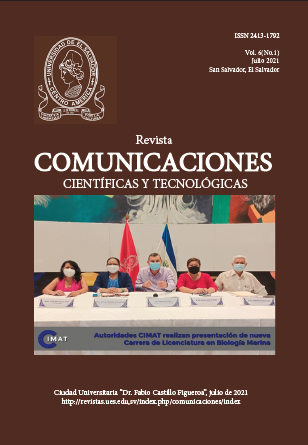Preparation of low cost SERS-substrates for virus characterization
Palabras clave:
SERS, Virus , Influenza, Efecto anillo de café, NanoparticulasResumen
Preparación de sustratos SERS de bajo coste para caracterización de virus
La espectroscopia Raman es una técnica que permite la caracterización y detección de una amplia gama de moléculas. La caracterización de biomoléculas y virus ha sido una aplicación novedosa en las últimas décadas. Un problema relevante para aplicar esta técnica es la baja intensidad de la señal de Raman y la baja concentración de analito, lo que dificulta bastante la identificación de moléculas y virus. Una alternativa para superar este problema es el uso de SERS (surface-enhanced Raman spectroscopy). Esto implica el uso de sustratos SERS que generalmente cuestan una cantidad considerable de dinero y solo se pueden usar una vez. En este trabajo, reportamos resultados preliminares de la detección de virus por SERS utilizando sustratos caseros de bajo costo y sustratos disponibles comercialmente. Se detectaron picos característicos Raman asociados a virus de la influenza. Los resultados obtenidos con los sustratos SERS caseros son comparables a los obtenidos utilizando los comerciales.
Descargas
Referencias
Ambartsumyan O, Gribanyov D, Kukushkin V, Kopylov A, and Zavyalova E. 2020. SERS-based biosensors for virus determination with oligonucleotides as recognition elements. Int. J. Mol. Sci. 21 (9): 3373. Available from: https://doi.org/10.3390/ijms21093373.
Chang CW, Liao JD, Shiau AL, and Yao CK. 2011. Non-labeled virus detection using in- verted triangular Au nanocavities arrayed as SERS-active substrate. SENSOR AC- TUAT B-CHEM 156 (1): 471–478. Available from: https://doi.org/10.1016/j.snb.2011.04.006.
Fan C, Hu Z, Riley L, Purdy G, Mustapha A, and Lin M. 2010. Detecting food- and waterborne viruses by surface-enhanced Raman spectroscopy. J. Food Sci. 75 (5): M302–7. Available from: https://doi.org/10.1111/j.1750-3841.2010. 01619.x.
Fernández Ramírez YP, Hoyos W, and Rudamas C. 2019. Absorption and reflectance spectroscopic characterization of cancerous and pre-cancerous cervical tissue. Rev. Cubana Fis. 36:106- 109. Available from: https://www.revistacubanadefisica.org/index.php/rcf/article/view/2019v36n2p106.
Galvan D and Yu Q. 2018. Surfaceenhanced Raman scattering for rapid detection and characterization of antibioticresistant bacteria. Adv. Healthc. Mater. 7 (13): 1701335(1–27. Available from: https://doi.org/10.1002/adhm.201701335.
Itoh T, Sujith A, and Ozaki Y: Surface–enhanced Raman scattering spectroscopy: Electromagnetic Mechanism and Biomedical Applications. In: Laane J. editor. Frontiers of Molecular Spectroscopy. Amsterdam: Elsevier. p. 289–319.
Kukushkin VI, Ivanov NM, Novoseltseva AA, Gambaryan AS, Yaminsky IV, Kopylov AM, and Zavyalova EG. 2019. Highly sensi- tive detection of influenza virus with SERS aptasensor. PLoS One 14 (4): e0216247(1– 14). Available from: https://doi.org/10.1371/journal.pone.0216247
Kumar A, Zhang Y, Li D, and Compton R. 2020. A minireview: how reliable is the drop casting technique? Electrochem. commun. 121: 106867(1–10). Available from: https://doi.org/10.1016/j.elecom.2020.106867
Lin YY, Liao JD, Ju YH, Chang CW, and Shiau AL. 2011. Focused ion beamfabricated Au micro/nanostructures used as a surface enhanced Raman scattering- active substrate for trace detection of molecules and influenza virus. Nanotechnology. 22 (18): 185308(1–8). Available from: https://doi.org/10.1088/09574484/22/18/185308.
Lipkin WI and Anthony SJ. 2015. Virus hunting. Virology 479-480: 194–199. Available from: https://doi.org/10.1016/j.virol.2015.02.006.
Lu H. 2003. A longitudinal Study of a novel dot-enzyme-Linked immunosorbent assay for detection of avian influenza virus. Avian Dis. 47 (2): 361–369. Available from: https://doi.
Descargas
Publicado
Número
Sección
Licencia

Esta obra está bajo una licencia internacional Creative Commons Atribución-NoComercial 4.0.






